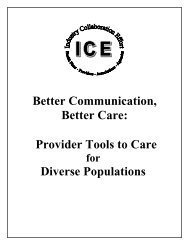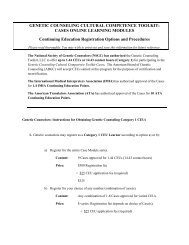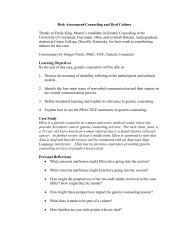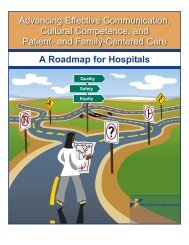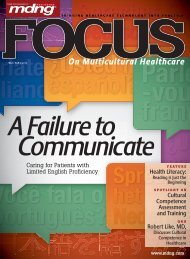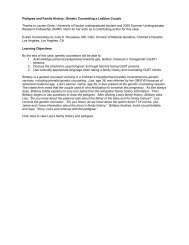making the business case for culturally and linguistically appropriate ...
making the business case for culturally and linguistically appropriate ...
making the business case for culturally and linguistically appropriate ...
You also want an ePaper? Increase the reach of your titles
YUMPU automatically turns print PDFs into web optimized ePapers that Google loves.
Training <strong>for</strong> Interpreters in aHealth Care SettingL.A. Care Health PlanCLAS St<strong>and</strong>ards Met: 3, 4-7, 8See page 12 <strong>for</strong> list of CLAS St<strong>and</strong>ardsAPPENDIX LISSUE. The language needs of limited English proficient (LEP) patients enrolled in L.A.Care Health Plan (L.A. Care) exceed available bilingual providers. To better meet <strong>the</strong>challenge of providing <strong>culturally</strong> <strong>and</strong> <strong>linguistically</strong> <strong>appropriate</strong> care <strong>for</strong> a growing number ofimmigrant <strong>and</strong> LEP patients, L.A. Care initiated a number of programs to improve <strong>the</strong>cultural competency within <strong>the</strong> provider network, including Health Care Interpreter Trainingcourses offered to bilingual employees in <strong>the</strong> L.A. Care network.DISCUSSION. L.A. Care Health Plan (L.A. Care) is a public health maintenanceorganization serving more than 750,000 people in Los Angeles County. L.A. Carecontracts with more than 10,000 health care providers annually, health plans, IndependentProvider Associations (IPA’s) <strong>and</strong> Medical Groups, community clinics <strong>and</strong> hospitals. Thehealth plan serves large populations with limited English proficiency. More than 55percent of patients prefer a language o<strong>the</strong>r than English, including Spanish (45 percent ofenrollees), Cantonese, Korean, M<strong>and</strong>arin <strong>and</strong> 27 o<strong>the</strong>rs.As part of <strong>the</strong> Cultural <strong>and</strong> Linguistic Services (CLS) Department’s strategic plan toincrementally achieve <strong>culturally</strong> <strong>and</strong> <strong>linguistically</strong> <strong>appropriate</strong> services, <strong>the</strong> Departmentdesigned <strong>and</strong> implemented <strong>the</strong> Health Care Interpreter Training project through whichqualified <strong>and</strong> experienced interpreters teach <strong>the</strong> basic principles of converting messages fromone language to ano<strong>the</strong>r in a health care setting. Classes are provided at no cost toparticipants. The curriculum is mobile <strong>and</strong> <strong>the</strong> instructor travels to clinic, hospital, <strong>and</strong>provider sites to better accommodate participants.The CLS Department developed a short class <strong>for</strong> providers (up to 4 hours) on patients’ rightsto interpreter services <strong>and</strong> how to work with interpreters, as well as a longer, 40-hour course,is offered to bilingual employees serving as interpreters. Continuing education credits areoffered <strong>for</strong> successful course completion. Participants in <strong>the</strong> short class includeadministrators, physicians, physician assistants, nurse practitioners, registered nurses,medical assistants, pharmacists, <strong>and</strong> health educators. The training explains <strong>the</strong> legalobligations to provide access to language services <strong>and</strong> discusses <strong>the</strong> impact of language <strong>and</strong>culture on <strong>the</strong> medical visit. The training also offers in<strong>for</strong>mation on ethical principles <strong>for</strong>health care interpreters <strong>and</strong> <strong>the</strong> benefits of working with a trained health care interpreter.O<strong>the</strong>r key topics discussed during this training include: 1) Tips <strong>for</strong> health care providers onhow to work effectively with an interpreter, 2) Tips <strong>for</strong> bilingual staff on how to workeffectively as an interpreter, <strong>and</strong> 3) Tips <strong>for</strong> using telephonic interpreters.The longer course was designed <strong>for</strong> introductory level training. It is divided into five (5)sessions of 8 hours each. Each session focuses on a specific <strong>the</strong>me, allowing participants togradually advance from basic to more complex subjects. It is an interactive course including56



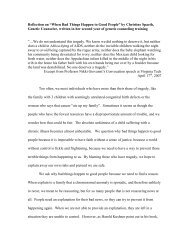
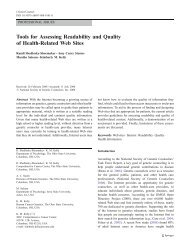

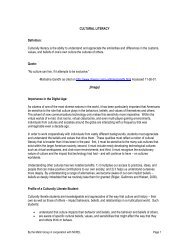
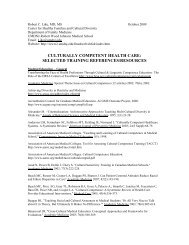

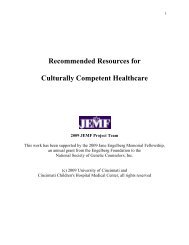
![Breaking Bad News PPT[1] - Genetic Counseling Cultural ...](https://img.yumpu.com/35003134/1/190x146/breaking-bad-news-ppt1-genetic-counseling-cultural-.jpg?quality=85)
